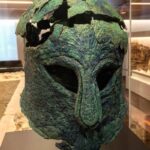
What was a Greek warrior doing in the Phoenician city of Malacca? In 2012 a grave appeared during a control excavation prior to some works on Jinetes Street, in the middle of the city. It is from the 4th century A. C. and it is calculated that it was outskirts of the Phoenician city, on a promontory.
That turned out to be a unique site, once explored, because it was excavated and built with perfectly worked armchairs – nothing usual in Phoenician tombs – and is today a central piece in the story of the new museum.
It was a Greek soldier or a Phoenician who acquired those weapons. Whatever be the case, that middle-aged man whose remains were in the grave must have been very important to deserve such a burial. The museum incorporates with this and many other elements the fruits of excavations and research of the past years in the area.
But Malaga and its new museum show at least two other unique graves of the time. One is extremely rare: a pit grave, an incomparable case in the Phoenician world, which has the delicate alabaster that carried the ashes in the center. To find the other one is necessary to venture on the ground floor of the museum, because it is shown in the visitable warehouse (worthy of seeing, because it is full of samples from the different collections, that is, arranged in the order of the warehouse). The plant of this grave looks like the one called “bullskin,” but it’s still being investigated. It was excavated by the Malagasy Nerea Archaeology and shows that under the asphalt remains our history.
Source : ABC
Espana, Luz de Trendo










Leave a Reply